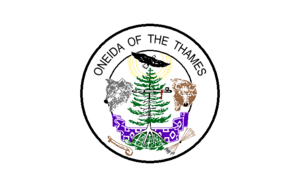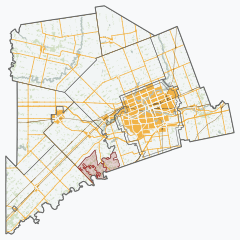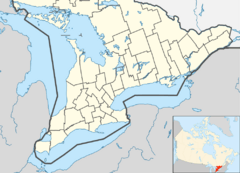Oneida Nation of the Thames facts for kids
Quick facts for kids
Oneida 41
|
||
|---|---|---|
| Oneida Indian Reserve No. 41 | ||
|
||
| Country | ||
| Province | ||
| County | Middlesex | |
| First Nation | Oneidas of the Thames | |
| Settled | 1840 | |
| Area | ||
| • Land | 22.16 km2 (8.56 sq mi) | |
| Population
(September, 2018)
|
||
| • Total | 2,175 | |
| • Density | 57.8/km2 (150/sq mi) | |
| Time zone | UTC-5 (EST) | |
| • Summer (DST) | UTC-4 (EDT) | |
| Postal Code |
N0L
|
|
| Area code(s) | 519 and 226 | |
| Website | www.oneida.on.ca | |
The Oneida Nation of the Thames is a First Nation community. It is home to the Onyota'a:ka (Oneida). This community is located in southwestern Ontario, Canada. It is often called the "Oneida Settlement." The settlement is about a 30-minute drive from London, Ontario. The Oneida Nation has over 6,100 members. About 2,100 of these members live on their land.
Contents
The Oneida Settlement: A Special Place
The Oneida are part of the Iroquoian-speaking Haudenosaunee people. Their traditional lands once covered a large part of eastern North America. The area of the Oneida Settlement was part of their hunting grounds. This area was recognized in the 1701 Nanfan Treaty.
The people living here today are descendants of Oneidas who moved from New York state in 1840. These early settlers were Christian. They belonged to the Methodist and Anglican churches. One of their leaders was a Methodist minister. Soon after arriving in Ontario, they built Methodist and Anglican churches. These churches have been important to the community ever since. Later, some people also joined the Baptist church.
Why "Settlement" and Not "Reserve"?
Indian and Northern Affairs Canada calls this land "Oneida 41 Indian Reserve." However, the Oneida people prefer to call it the "Oneida Settlement." This is because their ancestors actually bought the land in Ontario. It was not "set aside" or "reserved" for them by the government. This is different from many other lands for Indigenous people in North America, which are called "Indian reserves."
Before selling their lands in New York, the Oneida asked the Crown for a promise. They wanted to be treated the same as other Indigenous groups already living in Canada. After getting this promise, they bought land near the Thames River. They wanted their ownership of this land to be the same as other tribes. This meant the land would be held in trust for them and their future generations. This way, they would be treated like other tribes and not have to pay certain taxes.
Because they bought the land, some Oneida people today feel strongly about its status. They believe it is private property, not land held in trust by the Crown. They argue that the government should not have control over it. However, the government still treats Oneida as a reserve. The Oneida people often protest this, but they recognize it is the current situation.
There are reasons why this issue has not been fully resolved. It is hard to get everyone in the community to agree on how to prove their claim. There is also a lack of money to fight such a case. Plus, there is a fear of losing benefits that come with being a reserve. For example, if the government agreed it was private land, the Oneida might have to pay taxes.
How the Oneida Nation is Governed
The Oneida Nation has an elected Band Council. This council works with the Southern First Nation Secretariat. This is a group of Regional Chiefs' Councils. The First Nation is also part of the Association of Iroquois and Allied Indians. This group represents eight First Nation governments in Ontario.
The community also has a traditional, hereditary government structure.
Women Leaders in Oneida Nation
Oneida Nation of the Thames has had several women elected as chiefs.
- Virginia Summers was the first elected chief around 1963.
- Susan John served as acting chief later on.
- Sheri Doxtator, from the Turtle Clan, was elected in 2014.
- Jessica Hill was elected in 2018.
During her time as chief, Sheri Doxtator used a consensus-based approach. This meant everyone on the council worked together to agree on decisions. She held joint meetings with both the traditional council and the elected council. These meetings were open to all Oneida members. She worked closely with clan mothers and faith keepers. They discussed important community issues like well-being and the local economy. Chief Doxtator also helped start discussions between Oneida and nearby First Nations. These included the Chippewas of the Thames and Munsee-Delaware First Nation.
Community Life in Oneida
The Oneida community has three sub-divisions. It also has a community centre and three parks. Games like Bingo and radio bingo are very popular. Sports are also an important part of community life. Many people attend the longhouse and annual ceremonies. The Oneida language is taught to all children in school.
The Community Centre is a central place for community events. It was meant to be self-supporting by renting out rooms. However, it has often operated with a financial shortfall.
Keeping the Oneida Language Alive
In 2015, the Oneida Language and Cultural Centre opened a new building. This centre helps keep the Oneida language strong. In 2018, Marsha and Max Ireland worked on an Oneida sign language guidebook. This was a pilot project with elected councillor Olive Elm and a master speaker.
Important Facilities and Businesses
The Oneida community has a traditional longhouse and government. There are two main groups. The River Road Longhouse follows the Code of Handsome Lake and the Great Law.
Many Oneida people own their own businesses. These include craft shops, variety stores, and gas stations. There are also many smoke shops. The community has two elementary schools: Standing Stone and The Log School (Tsi ni yu kwali ho:tu')'.
A health clinic is located in downtown Oneida. This area also has a community-owned radio station. There is an administration building and a senior rest home. Other facilities include a volunteer fire hall and ambulance station. There is also a water treatment facility and sewage treatment facilities. A public works building, community centre, police station, and training centre are also present.
Annual Events and Celebrations
The Oneida Nation of the Thames holds an annual Oneida Fair. This fair takes place on the third weekend of September. In the past, the fair was a time to celebrate farming and rural life. People competed in agricultural events.
Today, most Oneida people do not rely on farming. Their lives are more like other populations in Canada. However, people still participate in the fair every year. They enter agricultural and home arts competitions, though on a smaller scale. Since the early 2000s, the Oneida Fairboard has sponsored a fireworks show. The fair also features musicians like Joanne Shenendoah and local artists.
The Oneida Fair is especially important for members who no longer live at the settlement. It is a chance for them to come home and reconnect with their community. Many people feel welcome at the fair because it is a fun, non-political event.
Nearby First Nation Communities
The closest First Nation neighbours to the Oneida are the Munsee-Delaware Nation and the Chippewas of the Thames.
Recent Community Successes
In 2007, the Ontario Ministry of Health approved a plan for the Oneida Nation. They approved licensing and funding for 64 long-term care beds. They also provided $2.8 million for construction. The First Nation is working with other groups on this project. This facility will create 70-80 jobs. It is expected to bring in $70 million over 20 years. It will also allow First Nations people to be closer to their families. They will also be able to take part in cultural activities.
Media and Radio
The Oneida Nation of the Thames has a community radio station. It broadcasts at 89.5 FM. This station is known as Oneida Radio 89.5 FM The Eagle or Eagle Radio 89.5.




